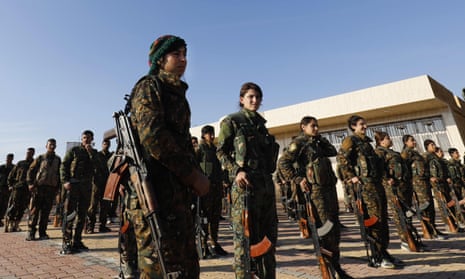Islamic State extremists have withdrawn from their last urban stronghold in Syria after weeks of intensifying clashes with Kurdish-led fighters that have splintered the remnants of the group’s leadership and raised fresh questions about the fate of its founder, Abu Bakr al-Baghdadi.
Isis forces retreated to villages to the east of Hajin in the early hours of Friday after several days of US airstrikes, which allowed Kurdish proxy forces to sweep into the town on the eastern bank of the Euphrates River. Clashes continued throughout the day, and western observers cautioned that the militants may be attempting to regroup for a counter-assault.
The fall of Hajin comes after the fight against Isis had stalled for several months, weighed down by the increasingly fraught politics of the seven-year war in Syria and its numerous spinoffs. Friction between two of its main protagonists, Turkey and the US, over Washington’s use of Kurdish proxies to lead the fight had been central to the slowdown, which raised fears that Isis was using it to consolidate after many months of withering losses.
The US had been urging Kurdish leaders to send experienced members to lead its proxy force in Hajin against a diehard contingent of about 2,500 Isis veterans of battles in Iraq and Syria, which have stripped the group of cross-border lands it once controlled and forced it to revert to guerrilla warfare. The US presidential envoy in the fight against Isis, Brett McGurk, said this week that nearly every Isis member in Hajin is thought to have access to a suicide vest.
Senior Isis leaders were believed to have sought refuge in Hajin over the summer, and Baghdadi is understood to have spent some time in the town since it became Isis’s de facto capital in late 2017. The surrounding province of Deir Ez-Zor was pivotal to the rise of Isis. Nearly 60% of the group’s revenues came from five nearby oilfields that were repeatedly attacked by US jets and quickly brought back online.
The province was an essential hub for Baghdadi’s couriers, drivers and intermediaries as the oil trade surged from 2014-15, and was seen as one of the few places left in a crumbling caliphate where Isis fighters could lay low.
Baghdadi is thought to have remained far from the fight in recent months, and western intelligence officials believe the fugitive leader to be in the northern half of Anbar province in neighbouring Iraq. Iraqi officials, however, suspect their quarry may have have been in Hajin more recently. “Most of the senior Isis leaders are based in Hajin,” said one senior official. “Moreover, the confessions of arrested Isis members all point to Baghdadi being there with his family.”
Isis’s leadership structure has collapsed over the past two years, leaving local leaders and sleeper cells to act without higher instruction. In north-eastern Syria, the focal point of the fight against the organisation, there has been an increase in the number of attacks in areas that had been cleared by the US-backed and Kurdish-led Syrian Democratic Forces (SDF), particularly the city of Raqqa, which had been one of two main hubs of power, Mosul in Iraq being the other.
The durability of the US-Kurdish alliance had been increasingly challenged since earlier this year, when the SDF suspended operations against Isis in eastern Syria as Turkey launched an operation to oust Kurdish forces from near its border in the country’s north-west.
The SDF has drawn heavily from local Arab populations to anchor the fight against Isis, but its leaders come from the ranks of senior Kurdish officials. As the fight against Isis winds down, the Kurds of Syria’s north-east have been weighing their options. A pledge of ongoing US patronage and weapons has kept the SDF in the fight in Hajin, but doubts about Washington’s future intentions and loyalties are increasingly testing the alliance.
Turkey’s announcement on Wednesday that it intends to send its military into north-eastern Syria poses a further challenge to the US-Kurdish pact. The US has described the planned move as unacceptable, but Ankara says it will defy the wishes of its Nato ally and will soon launch an operation aimed at pushing Kurdish groups allied to insurgents inside Turkey deeper into Syria.
A spillover from the fight in Syria is also believed to have energised an Isis revival in Kirkuk and Salaheddin in Iraq, local officials say. The number of assassinations and roadside bombs, trademarks of earlier insurgencies, have increased sharply in recent months.
Additional reporting by Nadia al-Faour
